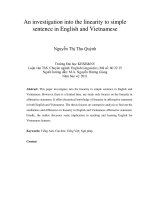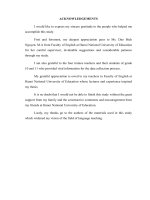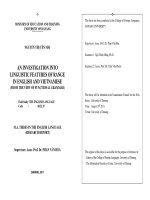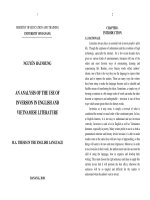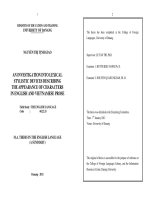An investigation into lexical stylistic devices describing the apperance of characters in english and vietnamese prose
Bạn đang xem bản rút gọn của tài liệu. Xem và tải ngay bản đầy đủ của tài liệu tại đây (122.56 KB, 13 trang )
1
2
MINISTRY OF EDUCATION AND TRAINING
UNIVERSITY OF DANANG
The thesis has been completed at the College of Foreign
Languages, University of Danang.
NGUYỄN THỊ TỊNH GIAO
Supervisor: LE TAN THI, Ph.D.
Examiner 1: HO THI KIEU OANH, Ph. D.
AN INVESTIGATION INTO LEXICAL
STYLISTIC DEVICES DESCRIBING
THE APPEARANCE OF CHARACTERS
IN ENGLISH AND VIETNAMESE PROSE
Field Study : THE ENGLISH LANGUAGE
Code
:
60.22.15
Examiner 2: NGUYEN QUANG NGOAN, Ph. D.
The thesis was defended at the Examining Committee.
Time: 7th January 2012
Venue: University of Danang
M.A. THESIS IN THE ENGLISH LANGUAGE
(A SUMMARY)
The original of thesis is accessible for the purpose of reference at
the College of Foreign Languages Library, and the Information
Resources Center, Danang University
Danang - 2011
1
2
CHAPTER 1
INTRODUCTION
always take center stage. The economic events, politics, society, and
1.1. RATIONALE
natural scenery and so on all contribute to the success and diversity
to literary texts. Among these factors, building the characters
Literature, an essential part in language and life, has two roles,
through their appearance plays a crucial role in achieving the best
an active, engaging role and a passive, reflective one. The former role
quality of works in prose. Appearance including costumes, gestures,
helps an individual form ideas and concepts about the world in which
behaviors, physical appearance and so on helps the writer convey his
they live in, the latter one is to “show” to society the history of
ideas and concepts to readers.
ideologies, of thought, and of action. It reveals what people thought
The main characteristic of a literary text is to use words to
during a particular time and how they thought about it. To some
express, use stylistic devices, especially lexical stylistic devices, to
extent, Literature is also considered as a great treasure of a nation, a
enhance the effectiveness of word expressions the writer used. To
territory, a region or even a remote and isolated area, belonging to
have good quality of art, a writer not only has to use language
culture and providing us with considerable knowledge of the people’s
effectively, colorfully and creatively in his literary works but also has
customs, habits, religions, rites, historical ages, lifestyles and their
to use stylistic devices to make his imagination and creation more
own ways of thinking.
and more accurate and vivid to arouse reader’s attention and interest.
One of the ways to express the ideas by writing media is
This is the reason explaining why lexical stylistic devices are
literature. Literature is an imagination of fact to express human
commonly used in describing people appearance in most literary
feelings. There are many definitions of the literature. One of them
texts. Let us consider the following examples:
according Rene Wellek and Austin Warren (1956:15) “Literature
(1) She doth teach the torches to burn right.
is a creative activity and art without artistic values literature
(2) He caught sight of her face, so white and motionless that it
would be just another kind writing, along with scientific, works,
[17]
seemed as though the blood must have stopped flowing in her veins.
reports, etc”. Literature helps us grow, both personally and
[18]
intellectually. It provides an objective base for knowledge and
(3) Tay lêu nghêu như cái sào, chân khuỳnh ra như kẹp lấy một
understanding. It links us with the broader cultural, philosophic, and
cái bánh lái tưởng tượng, giọng nói ào ào như thác lũ sông Đà, nhãn
religious world of which we are a part. Literature has three main
giới vòi vọi như nhìn về một bến xa nào ñó.
divisions; they are drama, poetry and prose. In this thesis I just
focus on analyzing of prose.
The common subject of literature is life, in which people
[76]
In (1) the writer uses metaphor as a lexical stylistic device to
describe the appearance of Juliet. This tells us that Juliet’s beauty is
much brighter than the torches in the dark night so she is very
3
4
beautiful. Whilst in (2) the writer uses hyperbole as a lexical stylistic
narratives. We also try our best to find out the similarities and
device to depict the very white and motionless face of Irene Heron.
differences in terms of the use of lexical stylistic devices as well as
This helps the reader imagine and “see” the image of the character
figure out the frequencies of occurrence of lexical stylistic devices in
quickly and effectively. In (3) Nguyễn Tuân uses simile as a lexical
English and Vietnamese prose.
stylistic device to compare the character’s appearance of the
1.4. RESEARCH QUESTIONS
boatman. This makes the appearance of the boatman more vivid and
appeal to the reader. It is clear that every writer employs lexical
1. What are lexical stylistic devices used to describe the
appearance of characters in EP and VP?
2. What are the similarities and differences in terms of the use
stylistic devices in his own discretion.
The use of lexical stylistic devices in character’s appearance
description has great impact on the readers. However, to what extent
of lexical stylistic devices in EP and VP?
3. What are the frequencies of occurrence of lexical stylistic
readers as well as the English learners recognize, understand and use
devices describing the appearance of characters in EP and VP?
lexical stylistic devices must be more exploited.
1.5. SIGNIFICANT OF THE STUDY
From the reasons mentioned above, I think it is essential and
1.6. ORGANIZATION OF THE STUDY
worthwhile to take an investigation into lexical stylistic devices
This thesis is divided into five chapters:
describing the appearance of characters in English and Vietnamese
Chapter 1, “Introduction” deals with the introduction of study,
prose. It is hopeful that “An Investigation into Lexical Stylistic
in which the rationale, the aims and objectives, the scope and the
Devices Describing the Appearance of Characters in English and
organization of the study are presented. The research questions are
Vietnamese
also included in this chapter as a guide to the following sections of
Prose"
will
bring
some
contribution
to
the
comprehension of lexical stylistic devices used in English and
Vietnamese prose.
1.2. AIMS AND OBJECTIVES
the thesis.
Chapter 2, “Literature review and theoretical background”,
makes a review of previous studies on stylistics in general and
1.2.1. Aims of the Study
stylistic devices in particular. Theoretical matters related to the study
1.2.2. Objectives of the Study
such as functional styles of the literary language, some notes on
1.3. SCOPE OF THE STUDY
With limited time and our own ability, in this thesis we just
investigate lexical stylistic devices describing the appearance of the
characters in English and Vietnamese novels, short stories and
prose, appearance and characters, definition and function of stylistics
and classification of lexical stylistic devices are carefully and
logically mentioned.
5
Chapter
3,
“Methods
and
6
procedures”,
presents
the
methodology and procedures of the study. Especially, the procedures
of the research are clearly described in logical order. Data collection
and data analysis are also mentioned in this chapter.
CHAPTER 2
LITERATURE REVIEW AND THEORETICAL
BACKGROUND
2.1. LITERATURE REVIEW
Chapter 4, “Discussion of findings”, deals with the findings of
The main aspects of this approach were first formulated in
lexical stylistic devices describing the appearance of characters in
Stylistics by Galperin [12], and subsequently elaborate in Leech and
English and Vietnamese prose, the discussion and analysis on the
Short [32].
similarities and differences in terms of the use of lexical stylistic
In “Prose Style” Book, Robert Milles, Marc Bertonasco and
devices as well as frequencies of occurrence of lexical stylistic
William Karns [22] focused on larger more content-based matters
devices in English and Vietnamese prose.
such as thesis statements, topic and support sentences, etc. , rather
Chapter 5, “conclusion and implications”, summarizes the
than on the sentence-level matters of styles .William Minto [37] in
main points discussed in chapter 4 and provides some implications
his book “ A Manual of English Prose Literature”, discusses about
for teaching and learning lexical stylistic devices in English and
the elements of Style including vocabulary, the sentence, the
Vietnamese prose. Last but not least, some suggestions for further
paragraph and figures of speech, the quality of style and kind of
studies are mentioned on.
composition.
In Vietnamese, there have been a number of scholars inspired
and interested in this. They are: Đinh Trọng Lạc, Nguyễn Thái Hòa,
Cù Đình Tú and Nguyễn Lai.
2.2. THEORETICAL BACKGROUND
2.2.1. Functional Styles of the Literary Language
2.2.2. General Notes on Prose
2.2.3. General Notes on Appearance and Characters
2.2.4. General Notes on Stylistics
2.2.5. Stylistic Devices
2.2.5.1. Definition of Stylistic Devices
Galperin [17] defines that a stylistic device is “a conscious
and intentional intensification of some typical structural and/ or
7
8
semantic property of a language unit (neutral or expensive)
promoted to a generalized status and thus becoming a generative
Simile
an explicit comparison (using as or Create
model”. It follows then that a SD is an abstract pattern, a mould into
like)
which any content can be poured.
different things which have at least arouse
2.2.5.2. Functions of Stylistic Devices
between
two
interest
Emotive effect
Based on the interplay of emotive
According to Galperin [17], stylistic devices can be divided
Epithet
and logical meaning in an
into three main categories: (i) phonetic, (ii) lexical and (iii)
attributive word, phrase or even
syntactical stylistic devices.
sentence
(b) Lexical stylistic devices
Table 2.3. The Summary of Lexical Stylistic Devices
Stylistic
Definition
Effect
devices
Metaphor
a comparison between two things, Create a vivid
combination of two terms which
Make the reader
are contradictory in meaning
think, express
criticism
Hyperbole
Deliberate overstatement or
Amuse the reader
exaggeration
Express author’s
opinion
which are basically quite different mental image and
without using like or as
arouse
readers’
interest
Metonymy
The object meant is not explicitly Build up imagery
named but rather substituted by a
closely
associated
feature,
a
characteristic part or a proper
name.
Irony
A SD based on the opposition of Humorous effect,
the two meanings, dictionary and express criticism
contextual one.
and the author’s
opinion
readers’
one feature in common
The
Oxymoron
vivid
distinctly mental image and
2.2.5.3. Classification of Stylistic Devices
(a) Phonetic stylistic devices
a
(c) Syntactical Stylistic Devices
9
10
CHAPTER 3
METHODS AND PROCEDURES
English and Vietnamese novels, short stories and narratives on the
Internet and in publication printing.
3.1. RESEARCH DESIGN
3.5.2. Data Analysis
3.2. RESEARCH SUBJECT
The collected data re examined and sorted out into categories
3.3. RESEARCH METHODOLOGY
The study will be carried out by using descriptive and
analytical methods.
3.4. RESEARCH PROCEDURES
of lexical stylistic devices. Particularly, we analyze and identify each
kind of lexical stylistic devices, then explain how it works and its
functions in a given context.
Step 1: Identify the lexical stylistic devices
In order to gain success in our research, the process of our
research follows the steps:
• We collect and analyze 200 English and Vietnamese samples
of describing the appearance of the character in Modern English and
Step 2: Explain how it works in a given context
Vietnamese prose and then sort out the data into categories of lexical
stylistic devices.
• We identify the category of the stylistic device, explain how
Step 3: explain its functions/ the effect on the reader
its works and find out its function in a particular text.
• We figure out the frequencies of occurrence of some
commonly used stylistic devices in English and Vietnamese prose.
Figure 3.1. Three Steps Analyzing Lexical Stylistic Devices
Finally, we figure out the frequency of the occurrence of each
• We discuss the results of the above analysis, compare and
category of lexical stylistic devices in English and Vietnamese and
contrast the similarities and differences in terms of the use of lexical
attempt to find out the similarities and differences in terms of lexical
stylistic devices in qualitative and quantitative approach.
stylistic devices describing the appearance of the character in English
• Finally, we suggest further research.
3.5. DATA COLLECTION AND DATA ANALYSIS
3.5.1. Data Collection
The study is carried out about 200 English and Vietnamese
samples of describing the appearance of the character in modern
and Vietnam prose.
4.1.
11
12
CHAPTER 4
DISCUSSION OF FINDINGS
was nothing; the light of the candles had as much soul in it as their
smile.
[5, p. 265]
IN
Another distributional model is the transferred epithet.
CHARACTER’S APPEARANCE DESCRIPTION IN
Transferred epithets are ordinary attributes generally describing the
ENGLISH AND VIETNAMESE PROSE
state of a human being, but made to refer to an inanimate object, as
LEXICAL
STYLISTIC
DEVICES
USED
we can see in the following examples:
4.1.1. The Epithet in EP and VP
According to Galperin [17], structurally, Epithets can be
viewed from the angel of (i) composition and (ii) distribution.
From the point of view of composition, we find only kinds of
compositional structure, namely simple and compound epithets. The
(4) Soames watched this rugged, enthusiastic careless face,
with an unpleasant feeling.
[18, p. 183]
In Vietnamese, many simple Epithets are used in describing
the appearance of characters. Here are some examples:
(5) Thì ra bà cũng ñẹp. Mọi ñường nét trên gương mặt bà ñều
following examples are simple epithets:
(1) Mr. Hewet turned his full face towards the window. They
rõ ràng. Lông mày cong, ñen và dày. Sóng mũi sổ thẳng, mạnh.
could see that he had large eyes obscured by glasses; his complexion
[70, p. 108]
was rosy, his lips clean-shaven; and, seen among ordinary people, it
In addition to simple Epithets, compound Epithets play a
appeared to be an interesting face.
[51, p.95]
Compound epithets are built like compound adjectives. For
crucial part in describing the appearance of characters in Vietnamese.
For example:
(6) Chị tôi ñã qua tuổi con gái lâu rồi, nhưng nét mặt thanh tú,
examples:
(2) At tea-time he was introduced to her father, an invalid who
had to be helped about, but who was ruddy and well-favoured, with
cái mũi thẳng, cái miệng tươi cười và ñôi môi ñỏ thắm của chị không
theo năm tháng mà nhạt nhòa ñi.
[70, p. 249]
[31, p. 177]
Reduplication is a specific characteristic in Vietnamese. With
From the point of view of distribution, we find two models of
the aim at adding color and vividness to their characters, there is no
snowy hair and watery blue eyes.
epithets namely, string and transferred epithets. In his depiction of
Rochester, Charlotte Bronte and D. H. Lawrence give string of
epithets:
(3) While they would pronounce Mr. Rochester at once
harsh-featured and melancholy-looking. I saw them smile, laugh—it
doubt that reduplication is a perfect device to support their aim.
(7) Một cô vợ mũm mĩm nhưng ñen ñúa, màu da nâu của ñất
vùng chua phèn, ngập mặn. Làm dâu năm năm mới có ngày làm vợ.
[70, p. 98]
14
13
In Vietnamese just one word is in comparison such as là or
4.1.2. Metaphor in EP and VP
One of the most useful and unique lexical stylistic devices is
như. After analyzing and categorizing the collected samples, we just
find the word như used in describing the appearance as in:
the metaphor. Let us consider the following example:
(8) It was like pushing the chair itself back into the past, when
(13) Cu Tý dắt nghé men theo bờ ruộng. Cái bóng dáng lũn
we began the old slow circuit round about the ashes of the bridal
cũn thấp tròn, úp cái nón tuy bé nhưng cũng còn quá to ñối với
feast. But, in the funeral room, with that figure of the grave fallen
người, trông như cây nấm.
back in the chair fixing its eyes upon her, Estella, looked more bright
and beautiful than before.
[12]
In Vietnamese, many writers are interested in employing
[84]
(14) Nong ngồi trước, anh ngồi sau, ôm lưng như ñôi ếch ngày
mưa rào, bốn bàn tay nắm ghi-ñông, nắm tay nhau, ñạp long vòng
quanh sân cỏ.
[73, p. 20]
metaphors in describing their characters. Here is an example of
4.1.4. Oxymoron in EP and VP
metaphors:
Syntactically, oxymoron is divided into three main types
(9) Đôi mắt lá răm không chớp, nhìn say mê chính mình. Mái
tóc rất ñen, rất dày, chỉ ñể quá vai buộc qua bằng một sợi len, nhưng
namely: (a) noun phrase, (b) adjective phrase and (c) verb phrase.
Noun Phrase
với dáng ñiệu có màu ñài cát. Lạnh luôn toát lên mình vẻ mê hoặc
Let us consider the following examples:
như một con công mái.
(15) But her ugly-beautiful mouth was still unmoved and sad.
[73, p. 11]
4.1.3. Simile in EP and VP
[31, p. 96]
Comparison in general is a device of comparing two things
using such terms as “like”, “as”, “as if” or “as though”. Let us
consider the following example
[20, p. 27]
(11) Again he looked at her, huddled like a bird that is shot
and dying, whose poor breast see panting as the air is taken from it,
whose poor eyes look at you who have shot it.
[31, p. 183]
(12) Now your hair, I don’t know what it is like! It’s as bright
as copper and gold, as red as burnt copper, and it has gold threads
where the sun shines on it.
(16) Skating to-day I saw the Gold Fairy. She is awfully pretty,
but I really don’t think her so lovely as I did last year.
(10) But my body was like a harp and her words and gestures
were like fingers running upon the wires.
Adjective phrase
[30, p. 14]
[40]
Verb phrase
(17) I watched. Purring. In my arms, he cried beautifully as I
admired his red, wrinkled feet.
[40]
In Vietnamese, oxymoron expressions are popularly employed
in describing the appearance of chacracters. Let us consider the
following examples:
(18) Nó không nói, không khóc, ñứng dậy ñi rất bình thường,
một vẻ bình thường ñầy kinh dị .
[70, p. 96]
16
15
(19) Hắn khẽ nhún vai, mặt nhăn nhúm lại, nhếch một cái cười
ñầy cay ñắng và và vẫn ñứng im nhìn tôi.
[67, p. 336]
Clausal hyperbole
Beside single-word and phrasal hyperbole, clausal hyperbole is
commonly used in many works, for example:
4.1.5. The Hyperbole in EP and VP
(25) He felt the fine flame running under his skin, as if all his
Single-word hyperbole
Let us start analyzing the following examples quoted from
veins had caught fire on the surface.
[31, p.66]
well-known novel and short story by Charles Dickens and D. H.
In Vietnamese:
Lawrence:
(26) Tôi biết rằng tôi ñang ñứng trước một cô Quế thật sự, cô
(20) He gulped down the brandy, and more brandy, till his face
became pale, his eyes burning.
[31, p.56]
(21) Her black eyes flaring at him, as if to forbid him to notice
her.
[31, p. 66]
gái nhỏ nhắn ñẹp hơn sự hình dung của tôi nhiều. Đôi mắt của cô như
ñang cười, long lanh sáng rực dưới hang mi dài rung rung.
[84]
Numerical hyperbole
(27) The eyes of Doctor T. J. Eckleburg are blue and
In Vietnamese:
gigantic—their retinas are one yard high. They look out of no face
(22) Bỏ bát cơm Tua ngồi như hóa ñá, ñen thui một khúc
but, instead, from a pair of enormous yellow spectacles which pass
xương khô gộc ngệch. Tách ra khỏi tất cả, ñóng kín các cánh cửa giao
tiếp, Tua hoàn toàn biệt lập.
[61, p. 59]
Phrasal hyperbole
over a nonexistent nose.
[16, p. 26]
Comparison hyperbole
(28) Her eyes were most wonderfully blue, bluer than forget-
Here is an example of phrasal hyperbole:
me-nots. She seemed to have a certain confidence in Gerald, and to
(23) So attractive that the Reverend Mr Crisp, fresh from
feel a certain motherly mistrust of him.
[28, p. 485]
Oxford, and curate to the Vicar of Chiswick, the Reverend Mr
In Vietnamese:
Flowerdew, fell in love with Miss Sharp, being shot dead by a glance
(29) Cọng cổ gầy như cọng cỏ vốn là ñặc ñiểm của mỹ nhân,
of her eyes which fired all the way across Chiswick Church from the
nhưng giờ ñây nâng khuôn mặt xanh xao, ruột rè, mấp mé một nhẫn
school-pew to the reading-desk.
nhịn, một khẩn nài.
[49, p.149]
In Vietnamese:
So…..that hyperbole
(24) Lạc ñưa mắt ren rén nhìn qua ñống lửa ñang cháy rừng
rực giữa căn lều. Phía bên kia một ánh mắt long lanh, trong ñáy mắt
thỉnh thoảng cũng lóe lên hai ñốm lửa, nhưng ấm nồng và chan chứa
tình người.
[61, p.24]
[70, p. 192]
Hyperbole is used to increase the effect of a description. It
creates a humorous effects as in:
(30) Cheeks and arms so hard and red that I wondered the
birds didn’t peck her in preference to the apples.
[95]
17
18
4.1.6. Irony in EP and VP
- Secondly, vividness, attractiveness, poetic flavor and
(31) I see no occasion for that. You and the girls may go, or
peculiarity are similar features in linguistic use to describe the
you may send them by themselves, which perhaps will be still better,
appearances. Each writer has his own talent and creativeness to make
for as you are as handsome as any of them, Mr. Bingley may like you
the appearance of his characters more and more vivid and appeal to
the best of the party.’
readers.
[2]
In Vietnamese:
- Thirdly, all lexical stylistic devices used in describing
For humour
appearance in EP and VP have high artistic effects in the way of
(32) Sư ông lấm lét nhìn trộm Xuân rồi gãi tai như một sư ông
hợp thời trang.
[69, p. 50]
For pity
describing, drawing attention to the appearance, making a strong
impact on readers to arouse their interest and entertain them.
- Fourthly, Simile used in depicting appearance of characters is
(33) Cái khăn lượt với cái áo thụng xanh làm cho chú rể trở
the same in both English and Vietnamese. It is an explicit comparison
nên trịnh trọng một cách ñáng thương. Và hãy tưởng, anh ấy ñóng
between two different things that resemble in at least one way. It is
trang phục ấy suốt ngày lẫn ñêm.
expressed by comparative words such as like (như), more… than
[81]
For mocking
(hơn), less… than (kém), etc.
(34) Vợ anh, thật vậy, là một người ñàn bà có cái nhan sắc của
một người ñàn ông không ñẹp giai. Hai con mắt nhỏ, ñôi gò má cao,
4.2.2 Differences
a.Epithets
cặp môi phàm phũ, dáng người thô tục, những ngón tay tròn và dài
như những quả chuối ngự.
Table 4.7. The summary of Epithets in EP and VP
[59]
Composition
4.2. SIMILARITIES AND DIFFERENCES IN TERMS OF
LEXICAL
STYLISTIC
CHARACTER’S
DEVICES
APPEARANCE
USED
DESCRIPTION
Distribution
Simple E Compound E Reduplication String E Transferred E
IN
English
IN
Epithets
ENGLISH AND VIETNAMESE PROSE.
Vietnamese
4.2.1 Similarities
Epithets
+
+
_
+
+
+
+
+
+
+
- Firstly, all of the six lexical stylistic devices (Epithets,
metaphor, hyperbole, simile, oxymoron and irony) are found in the
collected samples in EP and VP.
- Differences: Reduplication is a specific but popular case in
Vietnamese. Almost every Ephithet has its reduplicated form.
Phonogically, there are two main types of reduplication: full
19
20
reduplication such as: trầm trầm, buồn buồn, thon thon, etc. and
Table 4.9. The Summary of Hyperbole Used in Depicting
partial reduplication with three main sub categories such as: xanh
Appearance in EP and VP
xao, mảnh mai, lờ ñờ, lũn cũn,…etc.
Hyperbole
ENGLISH
VIETNAMESE
Single-word hyperbole
+
+
Table 4.8. The Summary of Source Domain (less abstract)
Phrasal hyperbole
+
+
Used in Depicting Appearance in EP and VP
Clausal Hyperbole
+
+
b. Metaphor
Source Domain
ENGLISH
VIETNAMESE
Numerical Hyperbole
+
_
Animals
+
+
Comparison hyperbole
+
+
Human Beings
+
_
So……that Hyperbole
+
_
Natural objects
+
+
- Differences: According to table 4.9, Numerical hyperbole and
Artifacts
+
_
so… that hyperbole can not be found in the collected samples in
Abstract
+
_
Vietnamese.
Legendary characters
_
+
4.3.
- Differences: The source domains including human beings,
FREQUENCY
STYLISTIC
OF
OCCURRENCE
DEVICES
USED
IN
OF
LEXICAL
CHARACTER’S
artifacts and abstract (coachman’s half tamed leopard, first rate
APPEARANCE DESCRIPTION IN ENGLISH AND
atheletes, grave and graceful fancy) are used in describing the
VIETNAMESE PROSE
appearance of characters. These are not found in Vietnamses. Last
but not least, legendary characters such as Cô Tấm, Chị Hằng are just
used in Vietnamese.
c. Hyperbole
21
22
CHAPTER 5
35
CONCLUSIONS, IMPLICATIONS AND
RECOMMENDATIONS
30
5.1. CONCLUSIONS
25
This study aims at analyzing lexical stylistic devices used in
describing the appearance of characters in EP and VP and its
20
English
Vietnamese
15
achievements can be summarized as follows:
The aims and objectives of the study are clearly set up in
chapter One as a guideline for this study. Besides, the rationale, the
10
scope of the study, research questions, significant of the study as well
as its organization are logically mentioned in this chapter. Then we
5
give a brief review of the related previous studies in chapter Two.
This includes very significant theories such as: functional styles of
0
E
M
O
S
H
OR
the literary language, general note on prose; appearance and
characters and stylistics, stylistic devices with its definition, functions
Figure 4.1. Frequency of Occurency of Lexical Stylistic Devices
used descrbing the appearance in EP and VP
and classification. After that, we present the methods, procedure of
the study and data collections and analysis in chapter Three. Finally
based on the aims and objectives, the theoretical background and
research method in previous chapter, we carry out to categorize the
samples and analyze them. In addition, a contrastive analysis is also
carried out to find out the similarities and differences in terms of
lexical stylistic devices used in EP and VP. We find out some
important things like these:
Firstly, Epithet, metaphor, oxymoron, simile, hyperbole and
irony are the six commonly used lexical stylistic devices describing
the appearance of characters in English and Vietnamese. These
descriptions are very vivid and attractive thanks to the writer’s talent
23
24
and skill in using language and stylistic devices. These are two
decrease the intensity of the adjective, and is often used as a literary
factors making a literary work successful. It is noteworthy that he
device (like alliteration) in poetry and other compositions, as well as
uses a wide range of lexical stylistic devices with their functions as
in everyday speech. A lot of reduplicative epithets such as: xanh xao,
follows:
tròn trĩnh, mũm mĩm, thon thon, nhỏ nhắn and so on are employed in
- Arouse the reader’s interest or catch his/ her attention;
the collected samples. In addition, the images human beings, artifacts
- Make the reader think;
and abstract (coachman’s half tamed leopard, first rate atheletes,
- Create a vivid mental image;
grave and graceful fancy) are used in describing the appearance of
- Amuse or entertain the reader;
characters in English not in Vietnamese whilst legendary characters
- Criticize, mock or humorous effects
such as Cô Tấm, Chị Hằng are just used in Vietnamese. Finally,
Secondly, simple, compound, string and transfer Epithet are
so…. that and numerical hyperbole can not be found in Vietnamese.
found in both in English and Vietnamese. Remarkably, in these two
5.2. IMPLICATIONS
languages when depicting the beautiful appearance, the writer tends
5.3. LIMITATIONS
to employ the images of very nice natural objects and animals such
Due to the shortage of time, reference materials as well as the
as: flowers, autumn leaves, birds, the surface of the pond in spring
limited knowledge of the researcher, the study has got certain
and so on. With regard to the ugly one, the images of some animals
restrictions. Firstly, lexical stylistic devices are broad and describing
namely, monkeys, bats, pigs and rats are used in many texts. Thanks
the appearance of the characters has been concerned by many writers.
to the images of everyday objects and animals, readers can look back
Therefore, there are many materials related as expected and it takes a
on easily and efficiently no matter what these descriptions has poetic
lot of efforts to collect as well as to categorize them and then analyze
flavor and writer’s peculiarity. Through his characters, readers can
and contrast. Secondly, it is difficult for the researcher to choose the
share their feelings, ideas and thoughts with the writer. On a higher
contemporary writers in both English and Vietnamese prose.
level, talking about characters in a work of art is talking about
5.4. SUGGESTIONS FOR FURTHER RESEARCH
humanism in which human beings always take the central role and
have the right to give meaning and shape to their own lives.
Thirdly, with regard to the differences the findings show that
reduplication is really common in Vietnamese. They are formed by
repeating a part of a word to form new words, altering the meaning of
the original word. Its effect is to sometimes either increase or
1. An investigation into syntactical stylistic devices describing
the appearance of characters in English and Vietnamese prose.
2. An investigation into phonetic stylistic devices describing
the appearance of characters in English and Vietnamese poems.
3. An investigation into lexical stylistic devices describing the
landscapes in English and Vietnamese prose.




